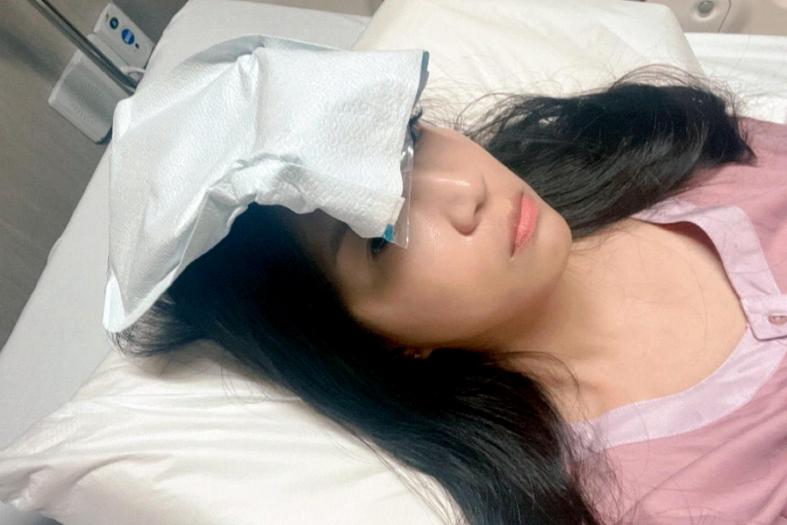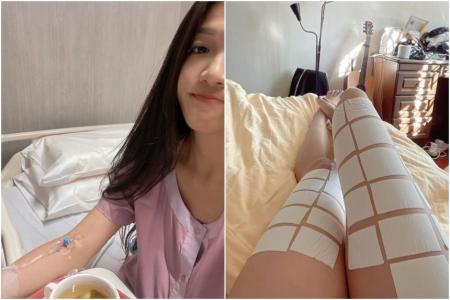I took a spinning class and ended up at a hospital's A&E clinic
Every nurse and doctor at Raffles Hospital who tended to me was sympathetic, but there was a knowing glint in their eyes as they asked me: "Spinning?"
If Covid-19 is the pandemic of our time then spinning-induced rhabdomyolysis feels like a virus, "infecting" people due to the seductiveness of a fun, accessible way to exercise.
As I lay in my hospital bed, I couldn't help but feel a little embarrassed for I thought the staff would think I was one of those impressionable young adults who went overboard while exercising after yielding to peer pressure in a spin studio with flashing lights and heart-pumping music.
I had heard of rhabdomyolysis before this incident but I brushed it off then, thinking I would not be so silly to push myself to that extent. How wrong I was.
My three-day hospital stay began with a 45-minute spinning class. I had initially booked a boxing class at a gym near my office but forgot my gloves that day so I decided to visit the nearby spin studio.
I was not a spinning newbie, having tried a few classes before the pandemic and I always enjoyed them. I usually do combat sports like boxing and muay thai, as well as swimming, once or twice a week.
About 10 minutes into the spinning class, I felt my thighs burning and did not turn up the resistance level of my bike when the instructor told the class to - although I still pushed myself.
I felt good after, though a little disappointed that I could not fully meet the demands of the class.
On hindsight, there were two things that I should not have done that day. Firstly, I left the class about 10 minutes earlier and skipped the cooling down stretches, as it was a lunchtime class and I had to rush back to work. Secondly, I had drinks with my colleagues after work and drank more alcohol than I usually did, which might have caused dehydration.
My thighs were aching quite badly the next day but I thought it was just regular muscle pain from working out. But the pain felt more intense than what I was used to and got worse the next day. I recalled that the activity can lead to rhabdomyolysis. I googled the symptoms and checked the colour of my urine - one of the signs of the condition is dark coloured urine - and it was normal.
But over the next two days, I woke up wincing at the pain and struggled to get out of bed. I resorted to plastering my thighs with rows of Salon Pas before bed each night.
The pain was so bad on the third day that I could hardly walk and I felt like my legs had been crushed by a truck. My urine was the colour of red tea by now.
But I was in denial that I had rhabdomyolysis from just a spinning class and delayed seeking medical help until the next day. The clinic sent me home with some painkillers, sachets of rehydration salts and I returned the next morning for blood and urine tests.
Just when I was feeling better, I received a call from the clinic to go to an Accident & Emergency department immediately.
At the hospital, I experienced first-hand how busy they were during the pandemic. There was no available bed at the first hospital I went to and they asked if they could transfer me elsewhere. I sat in a corner and called four to five hospitals to ask if there were beds in the tier that was covered by my insurance.
After a number of rejections, I finally got a bed at Raffles Hospital and was immediately put on intravenous drip.
I am terrified of needles and my first night at the hospital was a sleepless one due to the discomfort from the cannula and drip.
According to doctors, the level of creatine kinase (CK), an enzyme that is found in your skeletal muscle, heart muscle and brain, is below 200 for a healthy person.
When any of these tissues are damaged, they leak CK into your bloodstream. My CK level was over 7,000 when I was tested at the clinic and the general practitioner said my kidneys seemed OK, but I might have some liver damage.
When I took another blood test at the hospital, my CK level was actually over 45,800. This was because the lab that my GP sent my first blood sample to could only measure up to over 7,800. The doctor said I should be prepared to be hospitalised for four to five days.
During my stay, I drank lots of water and 100 Plus, and as a result, also spent a lot of time in the toilet.
On my second night in the hospital, I had a fever and the tears came as I lay in bed alone in the ward. I was upset as I did not know how much longer I would be warded and my anxiety was compounded by my discomfort and insomnia.

Ironically, I awoke to the sounds of Abba's "The Winner Takes It All" on the speakers the next day and I sang along loudly in my room.
And I won my freedom that day when my CK level went down to just above 7,800 and I was given the green light to be discharged. I was sent home with seven days of medical leave, painkillers and rehydration salts.
The indicative health markers in my blood and liver function tests were good a week after my discharge and no follow-ups were needed.
I took a walk around my neighbourhood a couple of days after being discharged but found myself worn out after walking a short distance.
After this scary experience with rhabdomyolysis, I wondered: How am I going to work out confidently again? How will I know if I am pushing myself too hard?
It has been over three weeks since my hospital stay and I still have not gone back to exercising. The pain in my legs is gone, but there is still lingering muscle weakness.
Unlike what Abba says, the winner doesn't take it all, so we don't have to be killing it all the time.
- Adelene Wong is a former sports journalist who now works in communications in the fintech sector.
Get The New Paper on your phone with the free TNP app. Download from the Apple App Store or Google Play Store now


